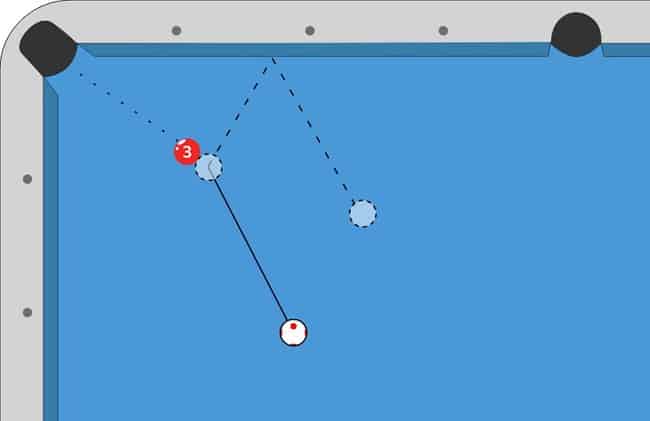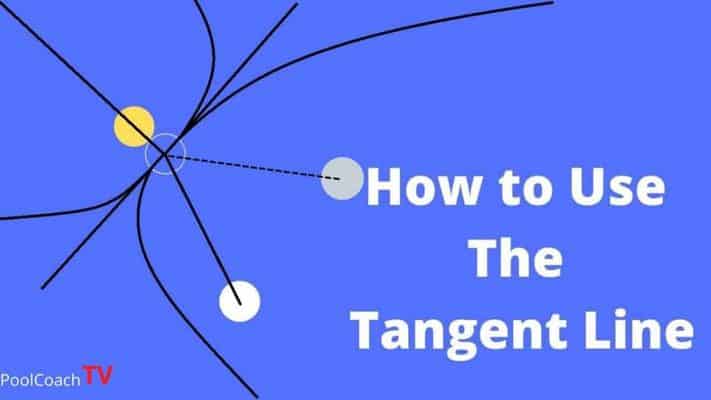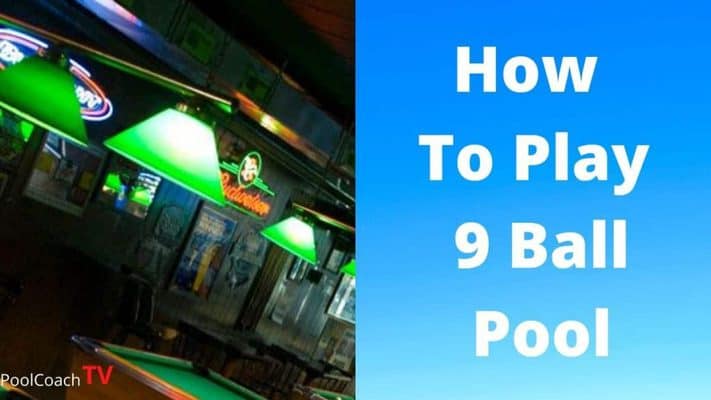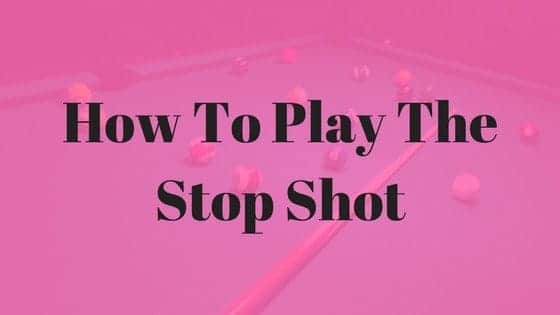Yes, the same tangent line that your geometry teacher at school was talking about years ago.
However, your teacher probably failed to give you a practical use for this line.
So let’s look at the tangent line and its practical applications in billiards.
Pay close attention: this could be the one piece of information that takes your game to the next level.
I had heard of this line years before I actually realized what an important guide to position it could be.
Simple Tangent Line Definition in Pool.
 The tangent line is the imaginary line that touches but does not cross a circle or curve at right angles or 90 degrees to its radius.
The tangent line is the imaginary line that touches but does not cross a circle or curve at right angles or 90 degrees to its radius.
In pool or billiards, this line will be assumed to run from the impact point of the balls to a rail on each side of the contact point, as in the illustration below.

The Tangent Line and Pool Balls that Collide.
If you look through the center of an object ball towards the pocket then draw a straight line towards the pocket as in the diagram, you will construct the line of aim.
In other words, the point on the ball at the end of the line nearest to you will be the impact point for the cue ball.
The Ghost Ball Aiming System.
It is necessary to just give a quick note about the ghost ball aiming system:
I am using the “ghost ball” as a convenient method of demonstration both in this article and when actually coaching the tangent line.
It is not the only method of aiming nor do I recommend it above any other method, it is just being used for easy illustration purposes.
So all things being equal, if your cue ball hits that exact point then the object ball will follow the aim line towards the pocket.
Are you still with me this far?
Great, I will get to the “all things being equal” comment later on, just bear with me for now and I will explain in detail later.
The contact point on the object ball will be the same from any location.
The position of the cue ball on the table makes no difference to this contact point.
Please read that Last sentence again….
If the impact point for numerous shot positions on the same object ball is the same then the corresponding tangent lines will also be the same.
Now For the Good Stuff!
The white ball will always leave object ball on the tangent line which is great news for you because now you have a point of reference to work from.
In other words, the cue ball will always leave the contact point at 90 degrees to the shot line.
When playing pool we are always looking for easily repeatable patterns. Patterns that we can pull up into our imagination time and time again when we are playing position.
When the cue ball leaves the object ball on the tangent line, it is repeatable and predictable.
How Does the Tangent Line Help us with Shape?
When the cue ball always leaves the object ball at the same angle we can use that information to calculate or visualize the cue ball’s path with a fair degree of accuracy.
It is helpful to look at the tangent line of a shot first, will this line enable me to get good shape on the next ball?
This will help you to know where the ball is going and to predict a likely path to the next shot.
You need to know the natural angle of each shot before you learn the effects of spin on the same shot. After all, if you don’t know where the cue ball is going naturally then how do you know when you need spin?
It is a baseline and foundation skill. When learning to play position, play shape and stay in line.
How To Make Sure The Ball Follows The Tangent Line.
On all cut shots the cue ball will travel down the tangent line and continue on towards the rail, so long as there is no spin left on the ball at impact.
- Vertical spin, top or bottom, can be applied to the ball but that spin must wear out before impact.
- If topspin is applied and is still present at impact, the cue ball will move above the tangent line.
- If backspin is applied and is still present at impact, the cue ball will move below the tangent line.
So how do we make sure that no spin is applied and that the cue ball takes the predicted path?
You need to practice your “straight in” stop shot.
The stop shot is where the cue ball stops dead. It does not move in any direction following impact with the object ball.
No spin at all.
No movement forward, backward or sideways.
There is no set way to practice this shot:
- Try different tip positions.
- Adjust your ball speed.
- Vary the distance between balls.
- Experiment with your stroke.
- Lengthen or shorten your follow-through.
Every player’s stroke is different. You must find out what works for you in order to succeed with the tangent line.
What is Contact Induced Throw – CIT?
Earlier in the article, I stated:
So all things being equal, if your cue ball hits that exact point then the object ball will follow the aim line towards the pocket.
On cut shots, at the point of impact, the cue ball and the object ball tend to momentarily cling together. This causes the object ball to take a slightly different course from the one predicted.
It will be as if the contact was “thicker” than intended.
Hence the name contact induced throw.
Slow speed and or an elevated cue will make the throw worse.
How To Adjust For Contact Induced Throw.
The main ways to adjust for CIT are to aim a little thinner than calculated. This will counteract the throw effect and send the cue ball along the desired path.
Some better players will add a small amount of outside english to the shot. In this case, the contact induced throw will be countered by the throw caused by the outside english.
Most players as they improve their game do not aim shots in a mechanical way. These pool players have played these shots so many times in the past that they “just know” where to aim.
Subconsciously they choose the right line and do not need to make adjustments.



